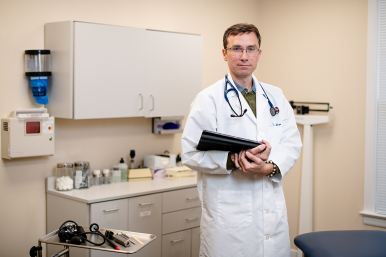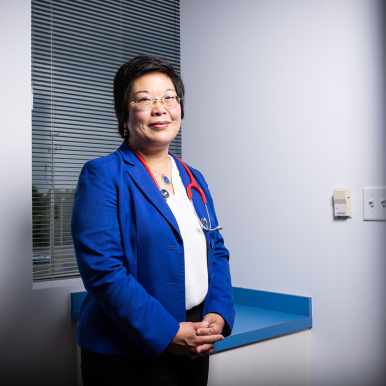In critical condition
Independent medical practices face long odds

After a decade co-owning and co-running a private practice, Dr. James Min of UVA Health Bull Run Family Medicine Haymarket joined a health system so he could “just work and see patients,” he says. Photo by Shannon Ayres

After a decade co-owning and co-running a private practice, Dr. James Min of UVA Health Bull Run Family Medicine Haymarket joined a health system so he could “just work and see patients,” he says. Photo by Shannon Ayres
In critical condition
Independent medical practices face long odds
For about a decade leading up to 2013, Dr. James Min was one of three physician-owners of a private practice in Prince William County, Bristow Run Family Medicine, working as a doctor by day and a finance manager by night.
“With the complexity of health care, billing, contracting with insurances, all these kinds of things, it became a lot of work as a physician,” he says. “You’re seeing patients during the day, and then you have to run the business at night. … It just kind of wears you down and gets very tiring.”
In addition to practicing medicine and keeping up with medical advances, Min handled financial duties for the practice, including payroll and billing, which meant he had to keep up with changes in Medicare billing regulations, follow up on denied insurance claims and evaluate employee benefits. Another partner handled the bulk of human resources, and the third oversaw IT.
In 2013, Min decided to join Winston-Salem, North Carolina-based health system Novant Health, which opened a Haymarket office for its Bull Run Family Medicine practice with him as its sole physician initially. Min sold his shares in the Bristow Run practice to his business partners.
“I decided that I wanted to just work and see patients, and it was OK for me to give up some of that autonomy but to have someone do the billing and HR and things like that,” he explains.
Min’s former Bristow Run Family Medicine partners also later joined Novant Health as a different family practice.
In January 2016, Novant formed a joint venture with the University of Virginia Health System for its Virginia operations, and in July 2021, UVA Health assumed full ownership of the system. Min is the medical group physician market executive for what is now UVA Community Health and continues to practice in Bull Run Family Medicine’s Haymarket office.
His story isn’t unique. In Virginia and nationally, the number of doctors in independent practices continues to shrink as physicians sell their practices, joining health systems, or retire in the face of ongoing and mounting challenges that are contributing to consolidation in health care.
In 2012, 60.1% of physicians worked in private practices, while 23.4% worked in practices at least partially owned by a hospital or health system, according to data from the American Medical Association’s Physician Practice Benchmark Survey. In 2022, however, only 46.7% of physician respondents worked in private practices, while 31.3% worked in practices at least partially owned by a hospital or health system.
Private practice benefits
Some physicians in private practices argue that they can provide better care because of their autonomy to make care decisions and the personal touch they provide, but there is also a measurable difference in patient costs between independent practices and health systems. A study of 580 health systems from Harvard University researchers and the National Bureau of Economic Research published in the Journal of the American Medical Association in January 2023 found that physician services delivered within health systems cost between 12% and 26% more than in independent practices.
Multiple factors contribute to that difference, but a major one is the difference in site-of-service fees associated with procedures like colonoscopies, explains Dr. Paul Berggreen, board chair and president of the recently formed Washington, D.C.-based American Independent Medical Practice Association. Medicare and many commercial insurers provide larger reimbursements for procedures’ facility fees to hospitals than to independently operated care centers.
“We want people to understand that we deliver high-quality care and … that independence and that segment of care delivery in this health care system needs to be maintained,” Berggreen says. “It’s good competition for the system.”
Doctors in private practices stress their autonomy in choices about patient care, like being able to spend more time with patients, as a major factor in their preferences for private practice.
Dr. Dan Moore started his practice, Henrico County-based RevMed, in 2021 after working at an urgent and primary care center owned by a chain, where he was pressured to see patients faster, he says.
In a typical urgent and primary care practice, “your job becomes how to generate [insurance] codes as fast as you possibly can,” Moore says, “because the amount of time I spend with a patient is irrelevant when it comes to compensation. … You essentially squeeze more and more productivity out of providers in a typical practice.”
Also, private practitioners feel that developing ongoing relationships with patients contributes to the quality of care they provide.
“When my [patients] call me, they don’t get whoever’s on call that day,” Moore says. “With me, my [patients] call me, they get me.”
Dr. Sandy Chung, CEO of Fairfax-based pediatric practice group Trusted Doctors and immediate past president of the American Academy of Pediatrics, says, “I think the hard part is as groups get bigger, what you lose is some of that personal touch that is so nice in a smaller practice.” However, patients might prefer the “sameness” of each visit or service at a large health system or practice, she points out.
Negotiating power
Cited as the largest obstacle to small physician-owned practices remaining private are low Medicare and commercial health insurance reimbursement rates. Medicare physician reimbursement rates have not kept up with the rate of inflation.
From 2001 to 2023, the cost of running a medical practice increased 47%, according to Medicare Economic Index data, but Medicare physician pay has only increased about 9%. Adjusted for inflation in practice costs, Medicare physician pay declined 26% from 2001 to 2023, according to the American Medical Association.

Medicare physician payment rates for 2024 will be 1.25% less than 2023 rates, although the Centers for Medicare & Medicaid Services are creating an add-on payment for outpatient and office visits for primary care and longitudinal care.
Reductions in Medicare payments affect independent physicians differently from hospital-employed doctors, Berggreen says.
“If we collect a dollar, we pay our overhead on that dollar and we take the rest home as what we get out of our salary,” he says, while hospital-employed physicians are largely unaffected, since their pay doesn’t hinge on how much Medicaid reimburses.
On the private insurance side, health systems are able to negotiate reimbursement rates with insurance companies directly, leveraging their size for higher payments. Private practices with a handful of physicians, however, don’t have the leverage to bring insurers to the bargaining table, meaning they must accept the contracts they’re offered if they want to continue accepting patients covered by those insurers.
“You try to contact an insurance company and ask about contracts, and if you’re just a three-doctor office, they don’t even sniff at you,” Min says.
In light of this, some physicians, like Moore, choose not to accept insurance. “It allows me to have independence and sort of get back to basics as far as how to design my practice,” he says.
Instead, RevMed operates on a membership model. Patients pay a monthly membership fee and don’t incur other charges, with a few exceptions like house call payments.
Other private practices have banded together to negotiate with insurance as a bloc. Take for example the Shenandoah Independent Practice Association, a group of more than 300 physicians in the larger Winchester area. Members pay dues for three years, which vest into a voting membership in the third year.
“We have the ability to negotiate [as] a collective group, and 300 physicians is no small deal,” says SIPA Executive Director
V. Allen Santos. Physician members are then able to opt in or out of the contracts SIPA negotiates.
At this point, Santos says, SIPA’s primary responsibility is getting the best possible deal on insurance contracts, but the organization’s structure allows him to seek other contracts for the group if requested, such as finding a groupwide electronic medical record vendor or hazardous waste disposal contractor.
Back-office help

Gaining help or having someone else entirely handle the business side of running a medical practice is another reason physicians join health systems.
Along with submitting claims to insurance and related tasks like providing prior authorizations for some prescriptions, physician practice owners have to navigate and stay abreast of patient billing, federal information technology and cybersecurity regulations, new Medicare billing regulations and other changes in health care law.
“The challenge is, when you have one or two clinicians, maybe one or two other staff, that’s your whole practice, and the ability to keep up with the laws, the changing rules, the IT requirements, all of those things, is really challenging,” Chung says.
Also on the rise are value-based care insurance programs, which provide a flat payment per patient, rather than per service, and often offer health care providers incentives for meeting quality metrics, which vary by program but can include hospital admission rates and number of cancer screenings. Some also offer profit sharing with providers.
“In order to do this kind of work, you have to have an infrastructure,” like employees who check on patients’ management of complicated medical conditions, Chung says. “For a small practice, it can’t afford to hire staff to do that, and you barely can get through the day seeing the patients that you need to see, much less have the bandwidth to be able to succeed in value-based care.”
Major health systems, though, generally have designated staff to monitor quality care metrics.
Another possible path that allows practitioners to stay independent in their clinical practices is joining a management services organization, or MSO — essentially a business office — often owned by a private equity firm, effectively outsourcing their back-office operations.
“The reason that practices have done that … is that we need access to capital to grow our practices, to improve our practices, to invest in the technologies and the manpower and the infrastructure that we need to compete,” Berggreen says.
Medical practice Mid-Atlantic Women’s Care, which has about 85 OB-GYNs across 37 locations, including some in Virginia, affiliated with management services organization Unified Women’s Healthcare in 2022, says Dr. Hugh Dixon Wolcott, who retired from clinical practice with Mid-Atlantic Women’s Care at the end of 2022 and is a consultant with Unified Women’s Healthcare.
Health system-affiliated hospitals have “tremendous amount[s] of resources” like data analytics, Wolcott says. “In order to basically try to have a level playing field, we need to have available those same types of resources,” like the ability to track quality metrics and offer simulation training. MSOs provide those resources, he says.
Unified Women’s Healthcare uses a fee structure, Wolcott says. Some MSOs, though, buy the physical assets of practices, like offices and equipment, and lease them back to doctors.
MSOs also take administrative tasks off doctors’ plates, like IT, billing and human resources, and can help provide scalability for costs like medical supplies.
For Min, the tradeoffs to join a larger system have worked out. Although working for a health system means he has less say over high-level decisions, he has a significant voice in the UVA Community Health subsidiary system and appreciates having a human resources department to help with hiring paperwork and others handling billing.
“My wife said I just sleep longer now,” he says.
s














